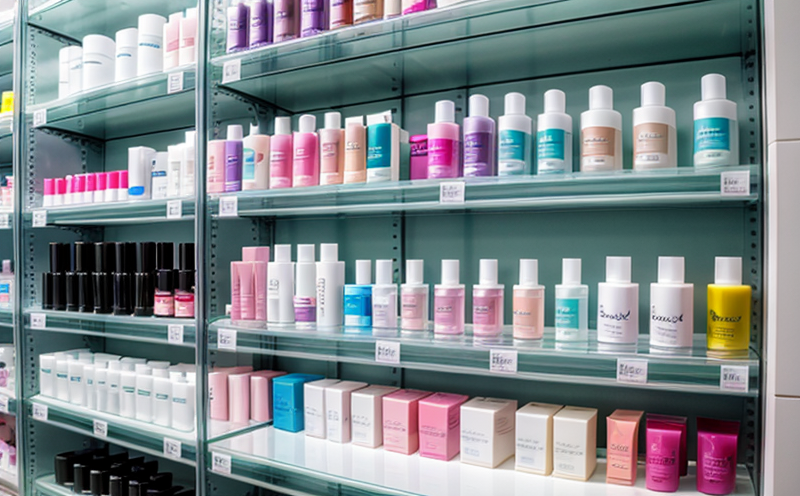Sunscreen Filter Stability Testing in Cosmetics
The stability of sunscreen filters is a critical aspect in the development and quality assurance of cosmetic formulations. Ensuring that these products maintain their efficacy, safety, and sensory properties over time is paramount for manufacturers to meet regulatory standards and consumer expectations.
Sunscreen filters are chemical or physical compounds designed to absorb, scatter, or reflect ultraviolet (UV) radiation. The stability testing ensures that the sunscreen maintains its intended protection levels throughout its shelf life. This involves a series of tests aimed at simulating real-world conditions such as temperature exposure, humidity, and light.
The first step in this process is the selection of appropriate test methods based on industry standards. Common tests include accelerated aging under various environmental stresses, stability studies over extended periods, and sensory evaluation to assess changes in texture and appearance.
Manufacturers often use high-tech equipment such as UV-Vis spectrophotometers and HPLC (High Performance Liquid Chromatography) for precise measurement of filter concentration. These tests are crucial not only for maintaining product quality but also for ensuring compliance with international standards like ISO 21750:2019, which sets guidelines for the stability testing of cosmetic products.
Another important aspect is the evaluation of the sunscreen's resistance to degradation from environmental factors such as heat and light. This involves exposing samples to controlled environments that mimic high-temperature storage conditions or UV light exposure, followed by analysis of any changes in active ingredient content or performance metrics.
The results of these tests provide valuable insights into how different formulations behave under various conditions. This information is vital for optimizing product design and ensuring consistent quality across batches. It also helps in identifying potential issues early on during development stages so that necessary adjustments can be made before commercial launch.
By conducting thorough stability testing, manufacturers not only enhance the safety profile of their products but also build consumer trust through transparent communication about product longevity and effectiveness.
Understanding these tests requires familiarity with both theoretical concepts and practical applications within the cosmetic industry. For those involved in R&D or quality assurance roles, having a deep understanding of sunscreen filter stability testing is essential for effective management of projects and resources.
Applied Standards
| Standard | Description |
|---|---|
| ISO 21750:2019 | International standard for the stability testing of cosmetic products, including sunscreen filters. |
| ASTM E346-18 | American Society for Testing and Materials standard covering photostability evaluation of sunscreens. |
| EN 928:2017 | European Norm for determining the resistance to light and heat of cosmetic products. |
| IEC 62717-4-3:2015 | International Electrotechnical Commission standard for measuring the UV protection factor of sunscreen products. |
| ASTM E988-17e1 | American Society for Testing and Materials standard providing recommendations for performing accelerated stability testing on cosmetic products. |
Benefits
The primary benefit of conducting sunscreen filter stability tests lies in the enhanced reliability and safety of the final product. By ensuring that sunscreens retain their protection levels over time, manufacturers can prevent potential health risks associated with insufficient UV defense. Additionally, these tests contribute significantly to brand reputation by demonstrating commitment to quality and consumer satisfaction.
From a business perspective, stable formulations reduce production costs due to fewer rejections during manufacturing processes and lower warranty claims from dissatisfied customers. Moreover, compliance with regulatory requirements strengthens the company's market position and facilitates easier entry into new markets.
For consumers, knowing that their sunscreen remains effective even after extended storage periods provides peace of mind. This translates directly into higher customer loyalty and repeat purchases, which are key drivers for long-term success in the beauty industry.
In summary, stability testing plays a vital role in safeguarding public health while supporting sustainable business practices. It bridges the gap between research and retail, ensuring that every product meets the highest standards of excellence before reaching consumers' hands.
Quality and Reliability Assurance
Ensuring high quality and reliability in sunscreen filter stability testing involves rigorous adherence to established protocols and continuous improvement practices. Quality assurance teams play a crucial role in overseeing every stage from initial formulation through final approval. They collaborate closely with R&D departments to integrate feedback into ongoing projects, thereby fostering innovation.
One key challenge is maintaining consistency across different production batches despite variations in raw materials or processing conditions. Advanced analytical techniques like near-infrared spectroscopy (NIRS) help monitor these variables throughout the manufacturing process. This ensures that each batch meets the same stringent criteria for UV protection and sensory attributes.
Reliability assurance goes beyond just meeting regulatory thresholds; it encompasses long-term performance under diverse environmental conditions. To achieve this, manufacturers may employ multi-location trials or simulate real-world usage scenarios in controlled settings. Such approaches provide comprehensive data that can inform future product development efforts.
In conclusion, a robust quality and reliability framework enhances stakeholder confidence by delivering consistent, high-quality products that exceed expectations both locally and internationally.





